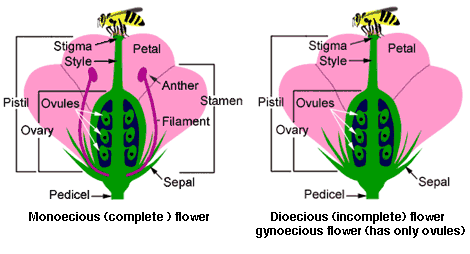A flower with sepals, petals, stamens, and pistils is complete. A flower lacking one or more of these structures is incomplete. Stamens and pistils are not present together in all flowers.
When both are present, the flower is perfect or bisexual, regardless of a lack of any other part that renders it incomplete.
Terms Referring to Flowers
- Complete – Flower containing sepals, petals, stamens, and pistil
- Incomplete – Flower lacking sepals, petals, stamens, and/or pistils
- Perfect – Flowers containing male and female parts
- Imperfect – Flowers that lack either male or female parts
- Pistillate – Flowers containing only female parts
- Staminate – Flowers containing only male parts

Terms Referring to Plants
- Hermaphroditic – Plants with perfect flowers (apples, tulips)
- Monoecious – Plants with separate male flowers and female flowers on the same plant (corn, squash, and pine)
- Dioecious – Plants with male flowers and female flowers on separate plants (maple, holly, and salt brush)
- Gynoecious – Plants with only female flowers
- Andromonoecious – Plants with only male flowers
Source: ext.colostate.edu
Links
- Plantpedia: Browse flowering plants by Scientific Name, Common Name, Genus, Family, USDA Hardiness Zone, or Origin

